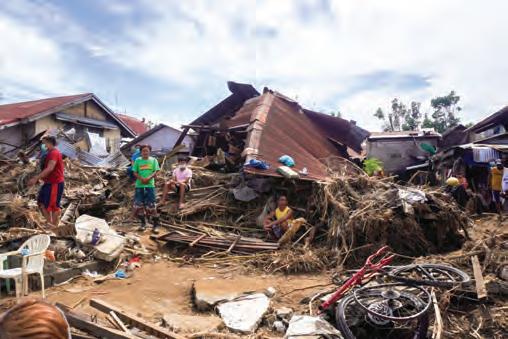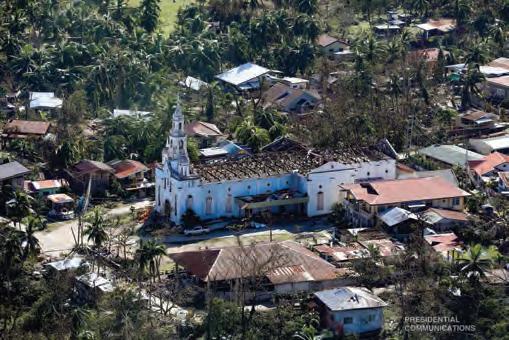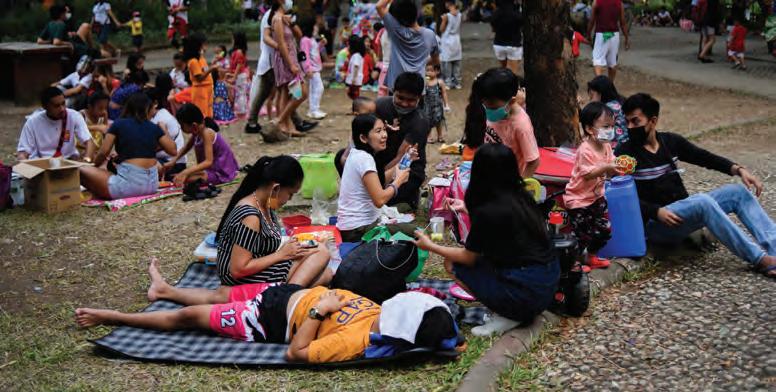
6 minute read
Page
Odette...
(From page 1)
Damage to agriculture, infrastructures and properties were initially estimated at P2.7 billion, but it could climb to over P10 billion as some provinces estimated their losses at P1 billion to P3 billion each.
As the government stepped up search, rescue and rehabilitation eff orts, including restoration of electricity, water and telecommunication facilities, international aid in the millions of pesos poured from the United States, United Nations and many countries.
But it will be black Christmas for thousands of residents of many provinces, towns and cities which were devastated by the typhoon, especially Bohol, Siargao and Negros island because restoration of power and telecommunication facilities will take more time or up to next year as many power transmitters and electric posts were destroyed and downed by powerful howler.
Authorities said the number of casualties may still rise as Bohol Governor Arthur Yap reported that those killed in the province alone climbed to 99 on December 22 and 20 missing with all 48 towns reporting, 13 of whom were in Ubay town, San Miguel and Loon town with six fatalities each and President Garcia town had fi ve fatalities.
In nearby Negros Oriental, fatalities rose sharply to 70 as of December 22 as search and rescue operations were stepped up, said Adrian Sedillo of the Negros Oriental Provincial Disaster Risk Reduction and Management Council.
President Rodrigo Duterte, who ordered immediate rescue and rehabilitation eff orts, inspected many areas devastated by the typhoon, approved a resolution placing six regions under state of calamity. Provincial and local offi cials earlier declared their areas under state of calamity.
Duterte committed up to P10 billion for aid to victims and rehabilitation.
Vice President Leni Robredo also visited several devastated areas and teamed up with Sen. Manny Pacquiao in extending aid. Other presidential aspirants – former Senator Ferdinand Marcos Jr. and Davao City Mayor Sara Duterte, Manila Mayor Francisco Domagoso, Sen. Panfi lo Lacson and Senate President Vicente Sotto III sent in their donations and relief goods to the victims.
Duterte approved a resolution submitted by the National Disaster Risk Reduction and Management Council (NDRRMC) placing regions 4B, 6, 7, 8, 10 and 13 (Caraga) under a state of calamity.
“The declaration of the state of calamity will hasten rescue, relief and rehabilitation eff orts of the government and private sector,” he said, adding that it will also help control the prices of goods and commodities in aff ected areas.
As of December 22, the Department of Agriculture said the agricultural damage and losses brought by the calamity stood at P2.6 billion.
Bohol Governor Yap released video showing rampaging fl oodwaters reached the second fl oor of his house in the town of Loboc, home of the famous Loboc river cruise.
The Philippine National Police (PNP) said that as of December 20, 375 people died following the onslaught of Typhoon Odette in Western Visayas, Central Visayas, Eastern Visayas, Zamboanga Peninsula, Northern Mindanao, and CARAGA. The NDRRMC, however, listed only 177 fatalities as of December 22.
Majority of the fatalities were recorded in the Caraga region (Region 13, 167) and Central Visayas (Region 7, 170), while 24 were logged in Western Visayas (Region 6), six in Eastern Visayas (Region 8), one in Western Mindanao (Region 9), and seven in Northern Mindanao (Region 10), the PNP said.
Around 51 people were reported dead in Negros Oriental, said Adrian Sedillo of the Negros Oriental Provincial Disaster Risk Reduction and Management Council.
Odette packed maximum sustained winds of 175 kilometers per hour near the center with gusts of up to 240 kilometers per hours when it slammed into Siargao and other areas in Mindanao and the Visayas, some of which were fl ooded. It is the strongest typhoon to hit the country this year.
President Rodrigo Duterte ordered massive relief and rescue operations, clearing of all roads and immediate restoration of power, telecommunication and water facilities.
Duterte inspected some of typhoon-hit areas, including Bohol and Leyte, met with local offi cials and informed them of an initial P2 billion allotment for relief assistance for those aff ected by the typhoon.
Later in a visit in Kabankalan City, Negros Occidental, President Duterte committed to raise an additional P10 billion for provinces severely aff ected by Typhoon Odette.


NCR ‘very low risk’ for Covid-19 in time for Christmas: OCTA

QUEZON CITY – The National Capital Region (NCR) is classifi ed as very low risk for coronavirus disease 2019 (Covid-19) with an average of only 79 new cases per day from Dec. 14 to 20, the OCTA Research Group said.
“The incidence or ADAR (average daily attack rate) was at 0.55 per day per 100,000 individuals while the reproduction number was 0.48,” the group said in its latest report.
It added that the NCR’s test positivity rate was 0.6 percent and it has an average of 18,127 RT-PCR tests over the past seven days.
The 15 local government units (LGUs) in the NCR classifi ed very low for Covid-19 include Pateros, Muntinlupa, Navotas, Caloocan, Marikina, Pasay, Taguig, Quezon City, Mandaluyong, Pasig, Malabon, Parañaque, Valenzuela, Manila, and Makati.
Among the 15 LGUs, only Pateros logged zero new cases of Covid-19. The other LGUs recorded one to 15 new infections. Their ADARs are below one.
Meanwhile, two LGUs -- Las Piñas and San Juan -- were classifi ed as low risk for Covid-19 with ADARs of 1.10 and 1.19 respectively. San Juan logged a healthcare utilization rate of 33 percent while Las Piñas has only 9 percent.
Over 26-M Filipinos living in poverty in fi rst half of 2021
QUEZON CITY — More Filipinos were pushed into poverty in the fi rst six months of 2021 compared to the same period of 2018, according to data from the Philippine Statistics Authority (PSA) and confi rmed by the National Economic and Development Authority (NEDA).
“We had set a target of reducing poverty by 6 million Filipinos by 2022. We have achieved that in 2018. But as of the fi rst half of this year, there are 3.9 million more poor,” Socio-economic Planning Secretary and NEDA chief Karl Chua said in a briefi ng.
Poverty incidence among Filipinos was estimated at 23.7%, up from the 21.1% recorded three years earlier. This means 26.14 million Filipinos were found to be living below the poverty line of ₱12,082 per month for a family of fi ve, the PSA said.
The data also indicated that poverty incidence among Filipino families stood at 18%, translating to 4.74 million poor families, higher than 2018’s fi rst-semester fi gure of 4.04 million.
The number of Filipinos living in subsistence or extreme poverty also increased to 10.94 million from previous 2018 data of 8.5 million.
“We have to work hard to at least bring them out of poverty before the term ends,” Chua said.
Chua said the poor will be the focus of the government as the country recovers from the pandemic. In a statement for the 2021 fi rst semester poverty statistics report, Chua said the government achieved four years ahead, or in 2018, the 2022 poverty goal of lifting six million Filipinos out of poverty.
He said that while hitting its target early, the government continued to implement reform programs like the social protection program Pantawid Pamilyang Pilipino Program (4Ps) to further uplift Filipinos’ lives.
“The results of the game-changing reforms are clear. Prior to the pandemic, economic growth averaged 6 percent, infl ation averaged 3 percent, and the rates of poverty and unemployment were at record lows,” Chua said. However, the pandemic hit and this hurt the gains the government achieved early on, he added. Chua said this will be addressed by the strengthened implementation of the programs towards achieving a more inclusive economy.
“We will also improve our social protection programs to support the vulnerable. To this end, we accelerated the implementation of the PhilSys or the national ID (identifi cation) program (to) provide every Filipino with a unique and digitalized proof of identity,” he said.




